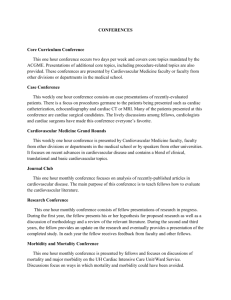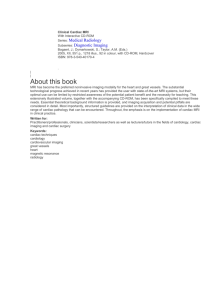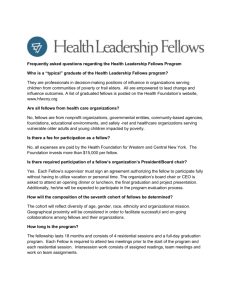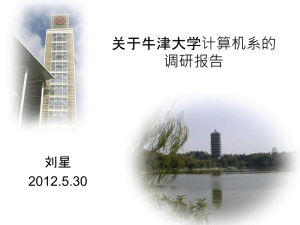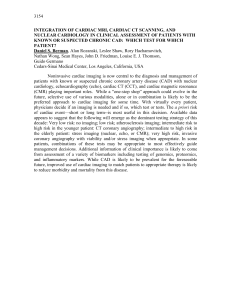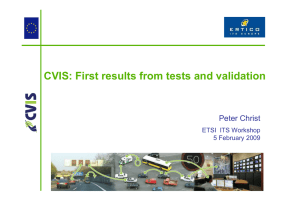here - Stanford University School of Medicine
advertisement
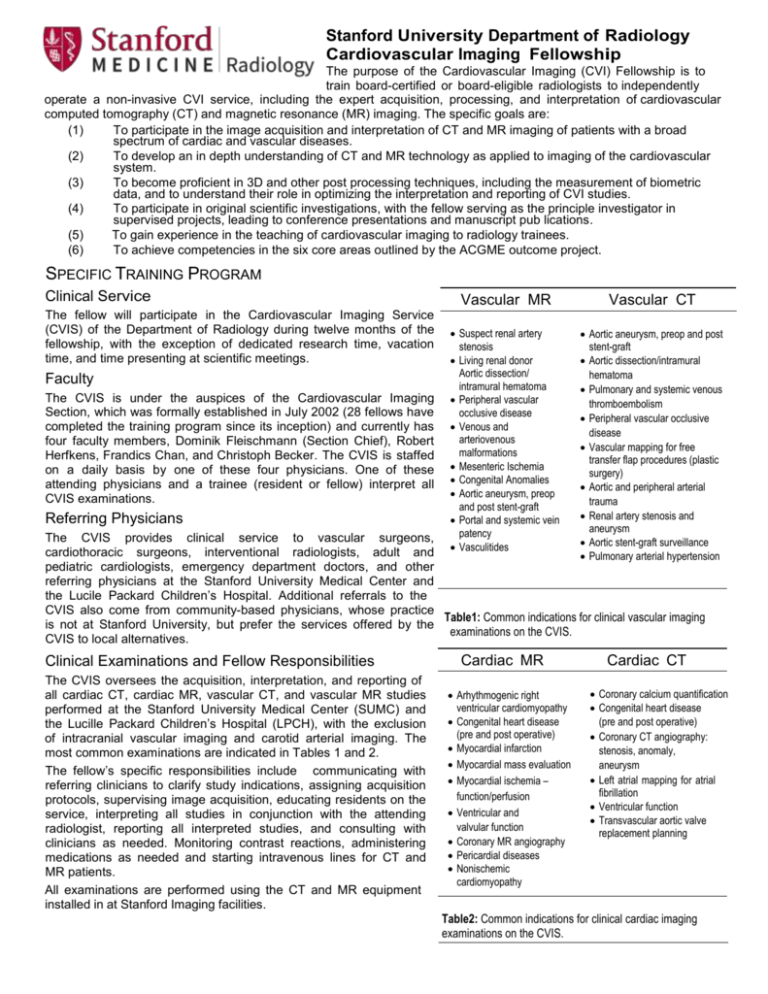
Stanford University Department of Radiology Cardiovascular Imaging Fellowship The purpose of the Cardiovascular Imaging (CVI) Fellowship is to train board-certified or board-eligible radiologists to independently operate a non-invasive CVI service, including the expert acquisition, processing, and interpretation of cardiovascular computed tomography (CT) and magnetic resonance (MR) imaging. The specific goals are: (1) To participate in the image acquisition and interpretation of CT and MR imaging of patients with a broad spectrum of cardiac and vascular diseases. (2) To develop an in depth understanding of CT and MR technology as applied to imaging of the cardiovascular system. (3) To become proficient in 3D and other post processing techniques, including the measurement of biometric data, and to understand their role in optimizing the interpretation and reporting of CVI studies. (4) To participate in original scientific investigations, with the fellow serving as the principle investigator in supervised projects, leading to conference presentations and manuscript pub lications. (5) To gain experience in the teaching of cardiovascular imaging to radiology trainees. (6) To achieve competencies in the six core areas outlined by the ACGME outcome project. SPECIFIC TRAINING PROGRAM Clinical Service The fellow will participate in the Cardiovascular Imaging Service (CVIS) of the Department of Radiology during twelve months of the fellowship, with the exception of dedicated research time, vacation time, and time presenting at scientific meetings. Faculty The CVIS is under the auspices of the Cardiovascular Imaging Section, which was formally established in July 2002 (28 fellows have completed the training program since its inception) and currently has four faculty members, Dominik Fleischmann (Section Chief), Robert Herfkens, Frandics Chan, and Christoph Becker. The CVIS is staffed on a daily basis by one of these four physicians. One of these attending physicians and a trainee (resident or fellow) interpret all CVIS examinations. Referring Physicians Vascular MR Vascular CT Suspect renal artery stenosis Living renal donor Aortic dissection/ intramural hematoma Peripheral vascular occlusive disease Venous and arteriovenous malformations Mesenteric Ischemia Congenital Anomalies Aortic aneurysm, preop and post stent-graft Portal and systemic vein patency Vasculitides Aortic aneurysm, preop and post stent-graft Aortic dissection/intramural hematoma Pulmonary and systemic venous thromboembolism Peripheral vascular occlusive disease Vascular mapping for free transfer flap procedures (plastic surgery) Aortic and peripheral arterial trauma Renal artery stenosis and aneurysm Aortic stent-graft surveillance Pulmonary arterial hypertension The CVIS provides clinical service to vascular surgeons, cardiothoracic surgeons, interventional radiologists, adult and pediatric cardiologists, emergency department doctors, and other referring physicians at the Stanford University Medical Center and the Lucile Packard Children’s Hospital. Additional referrals to the CVIS also come from community-based physicians, whose practice Table1: Common indications for clinical vascular imaging is not at Stanford University, but prefer the services offered by the examinations on the CVIS. CVIS to local alternatives. Clinical Examinations and Fellow Responsibilities The CVIS oversees the acquisition, interpretation, and reporting of all cardiac CT, cardiac MR, vascular CT, and vascular MR studies performed at the Stanford University Medical Center (SUMC) and the Lucille Packard Children’s Hospital (LPCH), with the exclusion of intracranial vascular imaging and carotid arterial imaging. The most common examinations are indicated in Tables 1 and 2. The fellow’s specific responsibilities include communicating with referring clinicians to clarify study indications, assigning acquisition protocols, supervising image acquisition, educating residents on the service, interpreting all studies in conjunction with the attending radiologist, reporting all interpreted studies, and consulting with clinicians as needed. Monitoring contrast reactions, administering medications as needed and starting intravenous lines for CT and MR patients. All examinations are performed using the CT and MR equipment installed in at Stanford Imaging facilities. Cardiac MR Arhythmogenic right ventricular cardiomyopathy Congenital heart disease (pre and post operative) Myocardial infarction Myocardial mass evaluation Myocardial ischemia – function/perfusion Ventricular and valvular function Coronary MR angiography Pericardial diseases Nonischemic cardiomyopathy Cardiac CT Coronary calcium quantification Congenital heart disease (pre and post operative) Coronary CT angiography: stenosis, anomaly, aneurysm Left atrial mapping for atrial fibrillation Ventricular function Transvascular aortic valve replacement planning Table2: Common indications for clinical cardiac imaging examinations on the CVIS. Imaging Facilities Clinical cardiovascular scans take place in two hospitals (SUMC and LPCH) and three outpatient centers. There are a total of 8 CT scanners: three 128-slice dual source CT (Siemens Flash), one 128-slice single source CT (Siemens AS+), three 64-slice single source CT (Siemens Sensation, GE 750-HD & GE VCT), one 16-slice single source CT (GE LightSpeed).There are 10 MRI scanners: six 3T units (GE MR750), two 1.5T units (GE TwinSpeed), one 1.5T unit (GE450-w), and one 1.5T unit (GE Horizon LX). All scanners are linked by PACS (GE Centricity). Interpretation Environment With the exception of image acquisition, and participation in interdisciplinary clinical conferences all activities of the CVIS take place in the CVIS Reading Room. The CVIS Reading Room is equipped with four high-performance PACS workstations for efficient analysis of the large CVI datasets (up to 15,000 images per study). Additionally, dedicated PCs are available for real-time 3D-image processing of clinical data using Terarecon AquariusNet and iNtuition systems, and for quantitative analysis of cardiac data using Medis QMass and QFlow. Interpretation sessions typically begin on the PACS station for a review of source images and then migrate to the 3D workstation for refined observation. This processing is entirely physician-driven and occurs as an integral part of the primary interpretation. 3D Laboratory In contrast to the 3D views created interactively during the primary interpretation of patient studies, technologists at the 3D Laboratory of the Department of Radiology perform high-quality image post-processing and detailed analysis of the patient data. All CVI examinations are processed by the laboratory for visualization using volume rendering, maximum intensity projections, and curved planar reformation. Additionally quantitative analysis is routinely performed to measure vessel diameters, lengths, angulation, and volumes. Flow analyses using MR phase-contrast information, ventricular volume measurements, and coronary calcium scoring are also performed routinely. These analyses are available to radiologists and referring clinicians within 2 to 24 hours following image acquisition and become part of the patients’ imaging records. It will be the fellow’s task to assure that processing is optimized for each patient study. As such, the fellow will serve as the chief liaison between the CVIS and the 3D Laboratory. Clinical Conferences The fellow will participate in the weekly Adult and Pediatric Cardiology/Cardiothoracic Surgery/Cardiovascular Imaging Conferneces, the Vascular Surgery and the Interventional Radiology Case Conferences. Participation includes presenting CVIS cases by accessing the 3D server in the 3D Laboratory and interactively demonstrating 3D and 2D visualization of the cases of interest. Interface with Cardiovascular Medicine The CVIS works closely with the Division of Cardiovascular Medicine (CVM) for the interpretation of cardiac MR examinations in adults. There are four CVM faculty members, Michael McConnell, Phillip Yang, Rajesh Dash, and Ian Rogers who jointly interpret cardiac MR exams with the CVIS faculty. The relationship is collaborative and collegial and is an important element of the CVIS fellow education to gain clinical and echocardiographic perspectives from cardiologists for our cardiac MR patients. Fellow Education One-on-one teaching between attendings and fellows is an integral part of the CVIS interpretation sessions. During the first month, the faculty of the CVIS and of the CVM give a series of 15, intensive, 90-minute lectures for the CVIS fellows covering topics in cardiovascular imaging and clinical medicines, such as cardiac anatomy, cardiac MRI and CT techniques and protocols, adult and pediatric heart disease, and acquired vascular diseases. Each month, two 60-minute conferences are presented to the Department of Radiology residents and fellows by the CVIS faculty. In addition, a monthly quality assurance meeting provides the forum to discuss active issues such as workflow protocol improvements, education evaluations, and difficult cases. An additional important source of the fellow’s education comes from the active monitoring of CT and MR acquisitions. One of the CVIS faculty members is always available during working hours to address urgent issues; however, the fellow will learn to independently supervise the acquisition of the full-range of clinical CVI studies in conjunction with CT and MR technologists. The fellows will spend two weeks observing studies in the adult echocardiography laboratory and read out cases with cardiologists. Each fellow has one month rotation in the chest service to learn pulmonary diseases. Finally, fellows will be trained to perform computer analysis of cardiac functions. Research Depending on the research productivity of the fellow, dedicated time will be allotted for research activities. Research projects will be supervised by a CVIS faculty specialized in the relevant area. The designs of the research projects are usually formalized during the early months of the fellowship. Typically, the fellow will be introduced to the research activities of the Section in the first month. Each of the faculty members will identify 1-2 potential initial projects appropriate for fellow participation. At least one of the projects from each faculty member will be at a point close to initial conception, allowing the fellow to serve as the principal investigator and carry the project through all phases of scientific investigation. The fellow will be expected to present results at a nationally recognized meeting and to write up completed study for publication. By the second month of the fellowship year, the fellow will be expected to select 3 projects – at least one with primarily MR focus and one with primarily CT focus from three different faculty members. Faculty members will supervise the progress of the fellow on their individual projects. In weekly research meeting, fellows present their interim progresses. When possible, fellows will be encouraged to conceive and develop their own research projects. Based upon the scope of the proposed research, Dr. Fleischmann or Dr. Chan will identify a project mentor. Teaching Responsibilities The fellow will present one 60-minute interesting CVI cases conference to the Radiology Residents each month at noon on dates to be determined. The fellow will present the cases interactively using the GE Centricity PACS via a projection system within the Radiology Conference Room. The fellow will additionally present using interactive volume rendering on the Terarecon AquariusNet o r i N t u i t i o n client-server system. The use of supplemental teaching material relevant to the individual cases will be encouraged. The conference will be supervised by at least one of the CVIS attending physicians. The fellow will additionally present two one-hour didactic lectures to the Radiology Residents on CVI topics of his or her choice. These lectures will be created in PowerPoint and presented using a computer. Relevance to Future Practice Upon completion of the fellowship, the graduate will be prepared to enter either academic or community practice in CVI. He or she will have a firm grasp of CT and MR principles and the imaging characteristics and pathophysiology of cardiovascular diseases. The graduate will be capable of establishing a 3D processing service to support all aspects of clinical CVI. He or she will understand how noninvasive CVI using MR and CT integrate into patient care and have the requisite knowledge to substantially expand CVI services or to build a CVI service at an institution where one previously did not exist. The graduate will have conducted CVI research from project conception to completion, providing at least an initial exposure that with continued mentorship could lead to a productive academic career. Finally, the fellow will be tutored and gain experience in the presentation of teaching conferences to radiology trainees, assuring that future generations of radiologists understand the fundamentals of this critical subspecialty. Compliance with ACGME Core Competencies Although the CVI fellowship is not accredited by the Accreditation Council for Graduate Medical Education (ACGME), it strives to meet the ACGME standard in core competencies in patient care, medical knowledge, practice-based learning and improvement, interpersonal and communication skills, professionalism, and systems-based practice. Expectations and goals in each of these areas are communicated clearly with the trainees at their orientation. Didactic lectures and individualized training are conducted with these goals in mind, as well as fostering the trainees’ ability to self-assess and independent study. Biannual evaluations provide feedback to trainees and identify areas of accomplishments and areas for improvements. Name of Host Institution: Stanford University Department of Radiology Specialty/Subspecialty: Radiology / Cardiovascular Imaging Address (Mailing & Physical Location): 300 Pasteur Drive, Room S-072, Stanford, CA 94305-5105 Phone Number: (650) 723-7647 Fax Number: (650) 725-7296 Address of Program Website: http://radiology.stanford.edu/education/clinical/fellowship.html#cv Program E-mail: madalat@stanford.edu Program Director: Frandics P. Chan, MD, PhD (madalat@stanford.edu) Alternate Program Contact: Malwana Adalat (madalat@stanford.edu)
